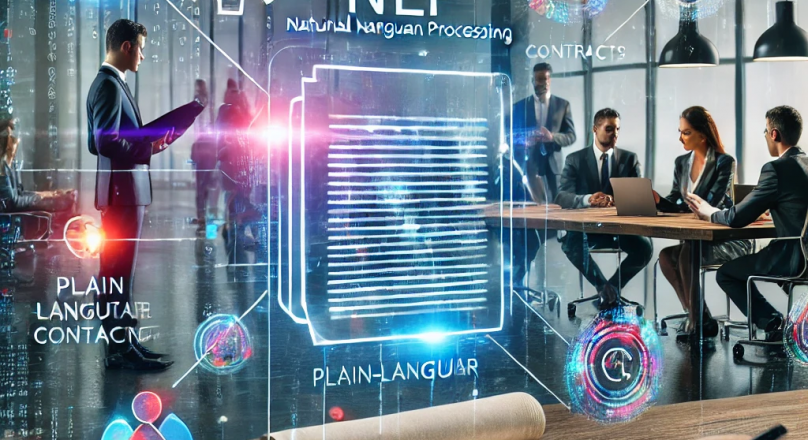Results for ""
The Need for Clarity in Legal Documents
For decades, a significant barrier to legal empowerment has been the inaccessibility of contract language. Whether it is a rental agreement, an employment contract, or a terms-of-service document for an online platform, people often struggle to parse the meaning behind complex legal phrases. This confusion can result in misunderstandings, financial loss, or even long-term legal repercussions. Access to clear, comprehensible information is the foundation of making informed decisions, and contracts should be no exception.
How NLP Bridges the Language Gap
Natural Language Processing—an AI-driven field focused on enabling machines to understand, interpret, and generate human language—is revolutionizing the way we interact with text. When it comes to contracts, NLP can:
1.Convert Legal Jargon into Plain Language:
NLP algorithms can automatically break down dense paragraphs into concise, readable summaries. By identifying key terms, clauses, and conditions, these systems provide an accessible overview of the core points. This helps individuals grasp the contract’s essence without feeling overwhelmed
2.Define Complex Legal Terms and Concepts:
Even after a contract is simplified, certain legal terms may still need clarification. Advanced NLP models can identify these terms and present context-based definitions, examples, or alternative explanations. Rather than needing a law degree, individuals can lean on AI to decode confusing terminology.
3.Offer Interactive Q&A Tools: Dynamic question-and-answer capabilities enable users to query specific sections of a contract. Want to know what happens if you terminate an agreement early, or how a specific clause protects your rights? With NLP-powered Q&A tools, individuals can ask natural-language questions and receive targeted, understandable answers. This empowers users to explore the document on their own terms, filling knowledge gaps as they go.
4.Highlight Potential Risks and Imbalances:
NLP-driven analysis can compare contract language against known best practices and identify clauses that may be unfavorable or one-sided. By flagging unusual terms—such as hidden fees, restrictive clauses, or ambiguous provisions—these systems help users spot potential pitfalls before signing.
Impact on Individuals and Society
1. Reducing Misunderstandings:
When people fully comprehend what they are agreeing to, the likelihood of disputes and dissatisfaction diminishes. Clear contracts mitigate the risk of future legal battles, saving both time and money for all parties involved.
2. Empowering Informed Decisions:
Understanding a contract is the first step toward making a smart choice. With AI tools translating documents into plain language, individuals gain the confidence to negotiate terms, seek further clarification, or walk away from a deal that does not serve their interests. This empowerment is especially critical for vulnerable populations who may be at a disadvantage when grappling with complex legal text.
3. Promoting Fairness and Transparency:
Making legal documents accessible levels the playing field. Whether you are a small business owner reviewing a vendor agreement or a consumer signing up for a new service, NLP-driven plain-language translations help everyone identify favorable conditions, question dubious clauses, and ultimately strive for more equitable transactions.
4. Reducing Reliance on Costly Legal Services:
While lawyers play a critical role in ensuring legal soundness, not everyone can afford professional counsel for every contract they sign. NLP-based AI tools provide an initial layer of clarity, allowing individuals to prepare more informed questions for an attorney—or, in some cases, to proceed confidently without legal help at all. This democratization of legal understanding can dramatically reduce the barriers to entry in business and personal decision-making processes.
Building a Future of Accessible Legal Information
As NLP and AI models continue to advance, we can anticipate even more sophisticated features, such as contract scenario simulations or negotiation assistance. Over time, these technologies will integrate seamlessly into everyday platforms, making the comprehension of legal documents a default, rather than a privilege.
The end goal is not to replace lawyers or legal advisors, but to create a more transparent, user-focused legal environment. By simplifying summaries, providing definitions, and enabling dynamic Q&A capabilities, NLP-based AI systems help people fully understand what they are signing. This shift from confusion to clarity ensures that individuals are no longer unwittingly bound by unfavorable terms. Instead, they enter agreements with eyes wide open, empowered to make decisions that align with their interests and values.
Conclusion
Natural Language Processing stands at the forefront of a significant transformation in how we interact with legal documents. By breaking down barriers to comprehension, NLP-driven AI solutions help protect consumers, encourage fairness, and foster trust between parties. Plain-language contracts are no longer a far-fetched ideal: they are a tangible reality, empowering individuals to take control of their legal affairs and confidently shape their financial and personal futures.
Sources of Article
Yatharth Garg (Synlex Intelligence)






